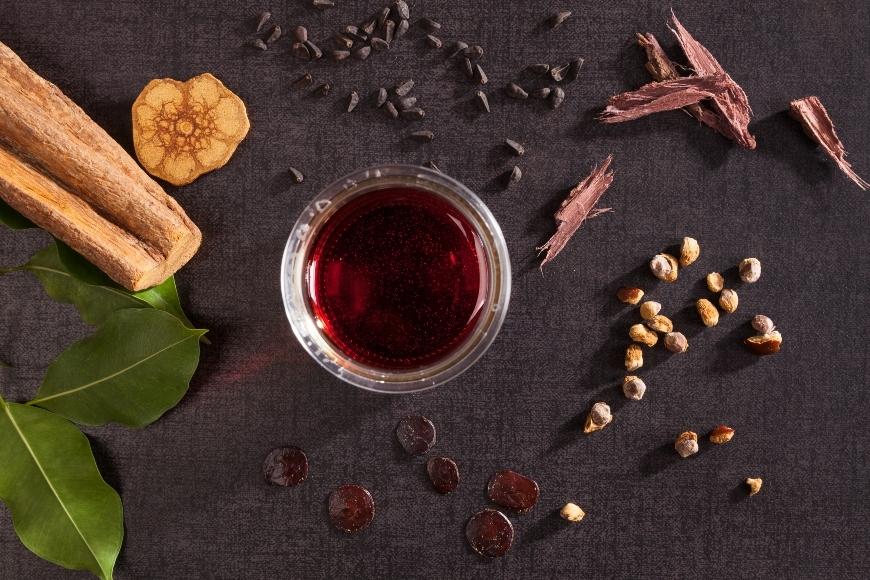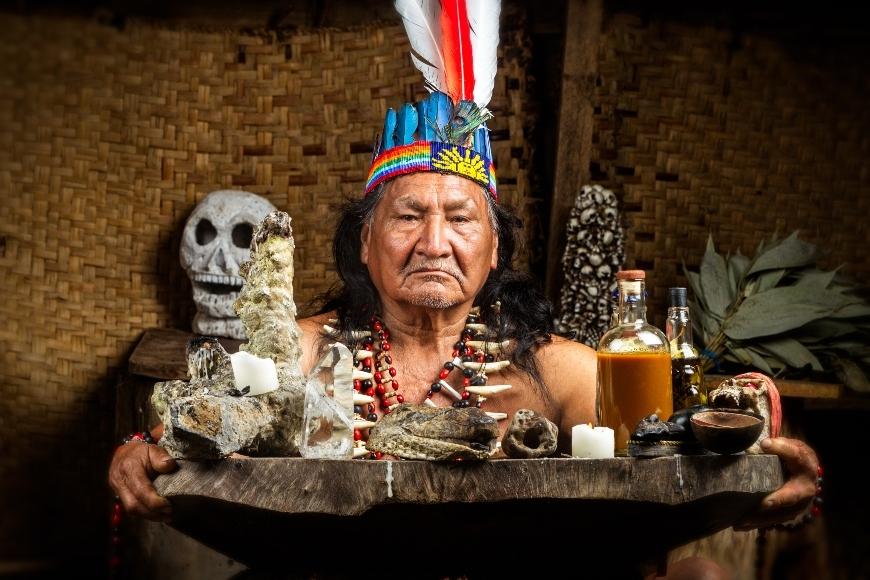Ayahuasca Vs Magic Mushrooms: What's the Difference?
Discover the key differences between Ayahuasca and Magic Mushrooms in our comprehensive guide, 'Ayahuasca Vs Magic Mushrooms: What's the Difference?'

Psychedelics encompass two intriguing substances, Ayahuasca and Magic Mushrooms, with ancient traditions and impressive impacts. But when it comes to "Ayahuasca Vs Magic Mushrooms: What's the Difference?", there's more than meets the eye.
From their chemical compositions to their psychoactive ingredients, these two naturally occurring hallucinogens offer distinct experiences. Delving into this blog post will illuminate not only how they vary but also provide a comprehensive understanding of each substance.
The intriguing history of Ayahuasca and magic mushrooms possibly dates back thousands of years, depicting shamans carrying mushrooms or brewing traditional spiritual brew originating from South America. How did they evolve from spiritual medicine to recreational drug? And what does science say about their effects?
We'll discuss all these aspects in detail along with legal status and safety considerations for taking Ayahuasca or Magic Mushrooms. So if you're eager to learn more about "Ayahuasca Vs Magic Mushrooms: What's the Difference?", keep reading!
Table of Contents:
- Exploring Ayahuasca and Magic Mushrooms
- The History of Ayahuasca and Magic Mushrooms
- Chemical Composition of Ayahuasca and Magic Mushrooms
- Effects of Ayahuasca and Magic Mushrooms
- Legal Status of Ayahuasca and Magic Mushrooms
- Safety Considerations for Using Ayahuasca or Magic Mushrooms
- Conclusion
Exploring Ayahuasca and Magic Mushrooms
For those looking to explore psychedelics, ayahuasca and magic mushrooms have become popular choices. Ayahuasca is a spiritual brew with a long history of use in Amazonian tribes, while magic mushrooms have been used both recreationally and ceremonially across various cultures.

Both substances contain psychoactive ingredients that produce strong effects, but the experiences can differ. Ayahuasca produces trips often characterized by intense psychoactive effects, including vivid visions and emotional introspection. In contrast, magic mushrooms tend to produce light sensory hallucinations and changes in mood and perception.
It's important to note that both substances come with potential risks and should be used with caution. Misuse can lead to adverse physical reactions or psychological distress. Before embarking on an ayahuasca or magic mushroom trip, it's crucial to understand your personal tolerance levels and the potency of the substance you're consuming.
The History of Ayahuasca and Magic Mushrooms
For centuries, Amazonian tribes have employed ayahuasca as a spiritual remedy. The brew is made from the ayahuasca vine and other plants that naturally produce the main psychoactive chemical, DMT. The exact recipes for ayahuasca vary depending on the tribe and shaman, but the brew is typically consumed in a ceremonial setting.
Magic mushrooms have a long history of use across various cultures. Evidence depicting shamans carrying magic mushrooms possibly dates back to 5000 B.C. The main intoxicating chemical in magic mushrooms is psilocybin, which produces intense hallucinations. Different species of mushrooms have varying levels of potency based on their psilocybin content, with some of the strongest species including Psilocybe cyanescens and Psilocybe hispanica.
The Risks of Ayahuasca and Magic Mushrooms
While ayahuasca and magic mushrooms can produce profound experiences, they also come with potential risks. Misuse can lead to adverse physical reactions or psychological distress, including anxiety, paranoia, and even psychosis. It is essential to take a measured approach when utilizing these compounds and only partake in them within a secure setting.
Additionally, it's worth noting that while ayahuasca and magic mushrooms have been used for spiritual and medicinal purposes, they are still considered illegal in many parts of the world. It's important to research the legal status of these substances in your area before considering consuming them.
The History of Ayahuasca and Magic Mushrooms
The use of magic mushrooms dates back to ancient times, with rock paintings depicting shamans carrying mushroom-like objects. These psychoactive mushrooms naturally produce psilocybin, the main intoxicating chemical that produces strong psychedelic effects. Today, many people view magic mushrooms as a recreational drug or therapeutic tool.
Ayahuasca is a traditional spiritual brew originating from the Amazon rainforest tribes, used as spiritual medicine for centuries. The term ayahuasca refers to a psychedelic brew made from two plants: Banisteriopsis caapi vine and Psychotria viridis leaves. The exact recipes vary depending on tribal traditions but always contain DMT (Dimethyltryptamine), the main psychoactive chemical producing intense hallucinations.
Ancient Mesoamerican cultures considered these "God's Mushroom" sacred and used them for religious rituals and healing ceremonies. In modern times, both ayahuasca trips and experiences with psychoactive mushrooms have been reported to provide profound psychological insights and personal growth opportunities when taken responsibly under appropriate guidance.
Psychedelic Effects and Differences
Ayahuasca and magic mushrooms both produce powerful psychedelic effects, but the individual's experience may differ based on dosage. Ayahuasca trips are often described as a grey, dream-like state with intense hallucinations, while magic mushrooms produce light sensory hallucinations and a strong psychedelic trip characterized by introspection and altered perception.
The main psychoactive chemical in ayahuasca is DMT, while magic mushrooms naturally produce psilocybin. The differences in potency and effects between the two substances are based on the species and the amount consumed.
Traditional and Modern Uses
Ayahuasca has been used for centuries as a traditional spiritual medicine, while magic mushrooms have been used for religious rituals and healing ceremonies. Today, both substances are used for recreational and therapeutic purposes, with many people seeking out ayahuasca retreats and magic mushroom experiences for personal growth and spiritual exploration.
It is essential to be aware that the utilization of both ayahuasca and magic mushrooms is prohibited in a multitude of nations, so their consumption should only take place under suitable supervision and within an authorized setting.
Chemical Composition of Ayahuasca and Magic Mushrooms
The psychedelic effects of both ayahuasca and magic mushrooms are due to their psychoactive ingredients. The main intoxicating chemical in magic mushrooms, also known as psilocybin mushrooms, is psilocybin. This compound naturally occurs in certain species within the genus Psilocybe, such as Psilocybe hispanica and Psilocybe cyanescens.
When ingested, the body metabolizes psilocybin into psilocin which then produces a strong psychedelic trip characterized by intense hallucinations. The potency based on these active compounds can vary depending on the mushroom's type and growth conditions.
A different set of chemicals is responsible for the effects produced by ayahuasca. This traditional spiritual brew originating from Amazonian tribes is made from two plants: Banisteriopsis caapi vine and Psychotria viridis leaves or other DMT-containing plants.
The term "ayahuasca" refers to this specific combination because each plant contributes essential psychoactive ingredients to create a unique effect profile. B.caapi's alkaloids, MAOIs, are combined with P.viridis' DMT to create a distinct effect profile; the latter being a powerful hallucinogen that requires an inhibitor like those found in B.caapi for oral ingestion to be effective.
Ingesting DMT alone isn't effective orally without an MAOI like those found in B.caapi; together they produce strong psychedelic effects similar but distinctively different than those caused by magic mushrooms.
It's important to note that exact recipes for ayahuasca vary depending on cultural traditions, leading to differences in its composition and resulting experiences during an ayahuasca trip.
Effects of Ayahuasca and Magic Mushrooms
The effects of both psychedelic mushrooms and ayahuasca vary depending on the dosage, individual's mental state, and environment. Nevertheless, they can create intense psychedelic impacts that can change one's experience of reality, emotionality and thought processes.
Magic Mushrooms
Magic mushrooms, also known as psilocybin mushrooms, possibly date back to prehistoric times with cave paintings depicting shamans carrying mushrooms. The main intoxicating chemical in magic mushrooms is psilocybin, which can produce a strong psychedelic trip characterized by visual distortions and enhanced emotional states. The potency of the trip is based on the species of mushroom and the dosage consumed. The trip usually lasts between 4-6 hours but can feel much longer due to time distortion.
Ayahuasca
Ayahuasca is a traditional spiritual brew originating from Amazonian tribes. It is made from a combination of DMT (N,N-Dimethyltryptamine) and MAOIs (Monoamine Oxidase Inhibitors). When consumed together, these ingredients work synergistically to induce an intense hallucination-filled journey often described as deeply introspective or even mystical. The term ayahuasca trip is a grey area legally speaking and typically lasts around 4-8 hours but can extend up to 10 hours for some individuals.
Many consider mushrooms and ayahuasca as spiritual medicine rather than a recreational drug. While some users report therapeutic benefits post-trip such as reduced depression or anxiety symptoms, scientific research is still ongoing regarding these claims.
Possible Risks
It's important for those interested in trying either substance recreationally or therapeutically to understand potential risks involved, including possible psychological distress during intense hallucinations produced by these substances along with physical discomfort like nausea, especially common after consuming ayahuasca tea made according to exact recipes that vary among indigenous communities where it originates.
Despite their potential to profoundly affect one's reality, magic mushrooms and ayahuasca must be approached with caution due to their powerful psychoactive effects. However, it's important to approach these substances with caution and respect for their powerful psychoactive effects.

Legal Status of Ayahuasca and Magic Mushrooms
The legal standing of ayahuasca and magic mushrooms varies from country to country. In the US, psychedelic mushrooms like Psilocybe hispanica and Psilocybe cyanescens from genus Psilocybe are classified as Schedule I drugs under the Controlled Substances Act, indicating a high potential for abuse with no accepted medical use.
This means they're considered to have a high potential for abuse with no accepted medical use. However, some cities such as Denver and Oakland have decriminalized them at a local level.
On the other hand, ayahuasca's legal status is more complex due to its main psychoactive chemical DMT being illegal in many places but exceptions exist for religious or spiritual use. For example, two Brazilian churches in America were granted permission by Supreme Court to use this traditional spiritual brew originating from Amazon rainforest during their ceremonies.
In contrast, countries like Brazil and Peru consider ayahuasca a cultural heritage and allow its consumption within a ritualistic context. Yet it's important to note that exact recipes vary so legality might change based on additional ingredients used.
As laws around these substances continue evolving worldwide - often towards decriminalization or legalization - it's crucial to stay informed about current regulations in your area before deciding whether you want an intense psychedelic trip characterized by strong hallucinations produced either by dried mushrooms or ayahuasca trips.
Safety Considerations for Using Ayahuasca or Magic Mushrooms
When considering psychedelics like ayahuasca and magic mushrooms, it is essential to prioritize safety. These substances can produce strong hallucinations and intense psychoactive effects, so it's important to understand the potential risks involved.
The term ayahuasca refers to a traditional spiritual brew originating from Amazonian tribes. Its main intoxicating chemical is DMT, which can induce an intense psychedelic trip characterized by vivid visualizations and deep emotional introspection. However, the potency of ayahuasca can vary depending on the exact recipe and preparation method used.
Magic mushrooms, also known as psilocybin mushrooms or 'god's mushroom', naturally produce psilocybin - the main psychoactive chemical responsible for producing strong psychedelic effects. The genus Psilocybe includes species such as Psilocybe hispanica and Psilocybe cyanescens that are commonly used recreationally.
While some view magic mushrooms as a recreational drug, others see them as spiritual medicine similar to ayahuasca. No matter your outlook, it's vital to bear in mind that the potency and personal response to either of these substances can be unpredictable.
To ensure safety while using either substance:
- Avoid mixing with other drugs or alcohol
- Stay hydrated throughout your experience
- If possible, have a sober sitter present who can assist if needed
- Avoid usage if you're dealing with mental health issues without professional guidance
Please note that this content is for harm mitigation only and should not be acted upon without professional advice. We do not endorse illegal activities nor take responsibility for actions taken based on this content.
The Fascinating World of Ayahuasca and Magic Mushrooms
Exploring the realm of psychedelics can be a captivating experience, particularly with ayahuasca and magic mushrooms at its core. These substances have deep roots in traditional spiritual practices, with depictions of shamans carrying mushrooms dating back thousands of years.
Ayahuasca is a traditional spiritual brew originating from South America that produces intense psychoactive effects due to its main intoxicating chemical DMT. The exact recipes for this psychedelic brew may vary depending on cultural traditions but generally include plants that naturally produce DMT.
On the other hand, magic mushrooms such as Psilocybe hispanica and Psilocybe cyanescens contain psilocybin, the main psychoactive chemical that produces light sensory hallucinations along with feelings of euphoria and introspection.
The Differences in Trips
The experiences or trips induced by these substances are vastly different too. An ayahuasca trip can be an emotionally intense journey through one's subconscious mind, often accompanied by strong hallucinations. In contrast, magic mushroom trips tend to produce light sensory hallucinations along with feelings of euphoria and introspection.
Legal Grey Areas
Both substances fall into grey areas across various jurisdictions worldwide due to their potent psychedelic effects and potential risks associated with misuse or abuse. It's essential to consider the potency of either substance, depending on your tolerance and psychological condition prior to use - be it recreational or therapeutic. Safety should always come first when dealing with powerful psychedelics like Ayahuasca or Magic Mushrooms.
These powerful psychedelics should not be taken for granted and must be approached with caution and respect. Take heed to avoid any misuse or abuse of these powerful psychedelics, for the potential consequences can be dire. Always approach these substances with caution and respect.
Conclusion
Ayahuasca vs Magic Mushrooms: What's the Difference? Two powerful psychedelics, Ayahuasca and Magic Mushrooms, have potential therapeutic benefits, but differ in active compounds, preparation methods, and cultural contexts. Ayahuasca is a brew made from two plants containing DMT and MAO inhibitors, traditionally used by indigenous communities in South America for spiritual purposes under the guidance of a shaman.
Magic Mushrooms contain psilocybin or psilocin, which can be consumed raw or dried to induce altered states of consciousness associated with mystical experiences. While both have potential benefits, it's important to understand the differences and cultural contexts before exploring their use.





















































































































